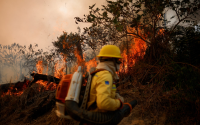Common Dreams / Published on Wednesday, September 5, 2007 by Inter Press ServiceAnuradha Kher
A study released Monday called “The State of the World’s Animal Genetic Resources”, conducted by the U.N. Food and Agriculture Organisation (FAO), found that an over-reliance on some breeds of livestock imported from the United States and Europe, including the high-milk-yielding Holstein-Friesian cows, egg-laying White Leghorn chickens, and fast-growing large white pigs, is causing the loss of at least one indigenous livestock breed a month.
Since research for the report began in 1999, 2,000 local breeds have been identified as at risk.
An example of over-reliance on a particular breed is the black-and-white Holstein-Friesian dairy cow, which is now found in 128 countries and in all regions of the world. Moreover, 90 percent of cattle in industrialised countries come from only six very tightly defined breeds.
The report, which the International Livestock Research Institute (ILRI) and other research groups also contributed to, surveyed farm animals in 169 countries and found that nearly 70 percent of the world’s entire remaining unique livestock breeds are found in developing countries. The findings were presented to over 300 policy makers, scientists, breeders, and livestock keepers at the First International Technical Conference on Animal Genetic Resources, being held in Interlaken, Switzerland from Sep. 3-7.
In order to prevent more breeds from going extinct, the FAO is in the process of leading inter-governmental processes to better manage these resources. But the negotiations and political processes will take several years to bear fruit. “And as we speak, breeds are disappearing. So we need to act now,” Dr. Carlos Seré, director general of ILRI, told IPS.
In response to these findings, scientists from the Consultative Group on International Agricultural Research (CGIAR), ILRI’s supporting organisation, have called for the rapid establishment of gene banks to conserve the sperm and ovaries of key animals critical for the global population’s future survival.
“This is the first step,” said Seré, who gave the keynote speech on the opening day of the Interlaken conference.
“In the U.S., Europe, China, India, and South America, there are well-established gene banks actively preserving regional livestock diversity,” said Seré. “Sadly, Africa has been left wanting and that absence is sorely felt right now because this is one of the regions with the richest remaining diversity and is likely to be a hotspot of breed losses in this century.”
Seré is calling for the rapid establishment of gene banks in Africa as one of four practical steps to better characterise, use, and conserve the genetic basis of farm animals for the livestock production systems around the world. “The cost of setting up gene banks is not too high. It’s more critical to get institutional support. So this can certainly be achieved in the poorest countries in Africa as well,” Seré explained.
Livestock conservation is important, given that industrialised countries built their economies significantly through livestock production and there is no indication that developing countries will be any different. Worldwide, one billion people are involved in animal farming and 70 percent of the rural poor depend on livestock as an important part of their livelihoods.
“For the foreseeable future,” Seré said, “farm animals will continue to create means for hundreds of millions of people to escape absolute poverty.”
Conserving local breeds in the developing world is crucial also because animals in those countries need to adapt to the environment, not the other way around. “If there is no veterinary care, local breeds can survive but not exotic or imported breeds,” he said.
For example, Uganda’s indigenous Ankole cattle could face extinction within 20 years because they are being rapidly supplanted by Holstein-Friesians, which produce much more milk. However, during a recent drought, farmers who had Ankole cattle were able to walk them long distances to get to water sources while those who had traded the Ankole for imported breeds lost entire herds.
Scientists and conservationists alike agree that all livestock populations can’t be saved. But ILRI has helped lay the groundwork for prioritising livestock conservation efforts in developing regions. Over the past six years, it has built a detailed database, called the Domestic Animal Genetic Resources Information System (DAGRIS), containing research-based information on the distribution, characteristics and status of 669 breeds of cattle, sheep, goats, pigs and chickens indigenous to Africa and Asia.
Sere’s proposed four-step plan is a snapshot of what the FAO is suggesting as a plan of action. Apart from establishing gene banks, he has called for the use of market-incentives and good public policy that make it in the farmer’s self-interest to maintain diversity. Greater mobility of livestock breeds across national borders and advanced genomic and geographical mapping techniques to predict which breeds are best suited to which environments are the other steps recommended to tackle this problem.
FAO’s Assistant Director-General Alexander Müller told the conference that climate change also posed a significant threat to livestock breeds.
“In this situation, the world cannot simply take a business-as-usual, wait-and-see attitude,” said Müller. “Climate change means that we are entering a period of unprecedented uncertainty and crisis, which will affect every country.”
“The options that these resources offer for maintaining and improving animal production will be of enormous significance in the coming decades,” he said. “Climate change and the emergence of new and virulent livestock diseases highlight the importance of retaining the capacity to adapt our agricultural production systems.”






